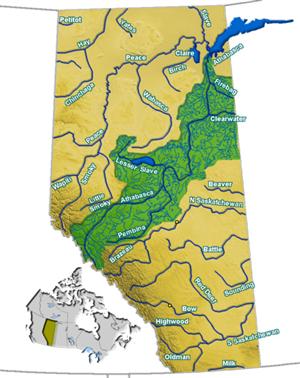The Drainage Basin
A drainage basin, or watershed, is “the area enclosed by a topographic divide such that surface runoff drains by gravity into a river, lake, or other water body” (WSC 2006). Drainage basins are often described as the area that contributes flow upstream of the mouth, or confluence, of a watercourse. A drainage basin can also be defined by the area upstream of a point where hydrometric (streamflow) data are measured, or upstream of a particular point of interest.
Rivers and the watersheds they drain are interconnected and interdependent. Because of this interconnection and linkages between upstream and downstream ecosystems, drainage basins provide a useful unit for considering and managing most environmental systems.
Basins occur at a variety of scales, with smaller basins (known as sub-basins) included within the basins of larger streams or rivers. Seen from above, river systems often display a tree-like pattern, with many small streams feeding into fewer larger rivers and eventually into one very large river. A stream flowing into a larger river is called a tributary to that river.
For example, the Athabasca River basin includes 138,000 km2 of land—mountains, plains, towns, agricultural land, and forest—that drain to the Athabasca River upstream of its terminus at Lake Athabasca. The Athabasca River basin includes the smaller basins of tributaries such as the McLeod, Clearwater, and MacKay rivers; these smaller basins are sub-basins of the Athabasca River watershed. In turn, these sub-basins contain still smaller catchments.
Drainage basins can be described by a number of characteristics, including:
- Size (area contributing flow, measured in km2). Rivers with larger drainage areas tend to combine the flow effects of numerous conditions found throughout the basin. Larger drainage basins tend to have greater variation in simultaneous weather conditions, and are usually less responsive to specific precipitation events.
- Terrain. In basins with steep terrain, a high proportion of precipitation may become surface flow, which is rapidly delivered to the river system. Flat terrain generally experiences more soil percolation and may contain more wetland areas, which store water.
- Climate. The amount of water delivered to the river system in the form of precipitation, the temperature that determines the type of precipitation, and the amount of evaporation are examples of climate effects on river flow patterns.
- Elevation. Elevation can affect climate (temperature and precipitation) and the storage of water as snow or ice.
- Aspect (terrain orientation). Aspect can affect snowmelt and the amount of evaporation, with south-facing slopes more exposed to the sun’s influence than north-facing slopes.
- Soils. Soil type affects the amount of water that can infiltrate the soil. Impervious surfaces (such as rock) within a drainage basin can lead to more surface water flow than in basins with more absorptive soils.
- Storage. Drainages with a greater proportion of lakes and wetlands tend to be less responsive to precipitation events due to potential water storage.
- Vegetation and Land Use. Vegetation and land use affect the amount of water reaching the river channel. Evaporation and transpiration from vegetation (evapotranspiration) return moisture to the atmosphere, while uptake of water and anchoring of soil by vegetation can reduce surface water runoff and erosion, respectively.
- Human Influences. Water diversions, withdrawals and discharges are potential human influences that can affect the water balance of a drainage basin. Features such as dams affect the natural flow regime of a river, resulting in changes to both the seasonal and yearly variations in water flow. Human impacts on vegetative cover and land use within the drainage basin can affect infiltration and runoff patterns.









